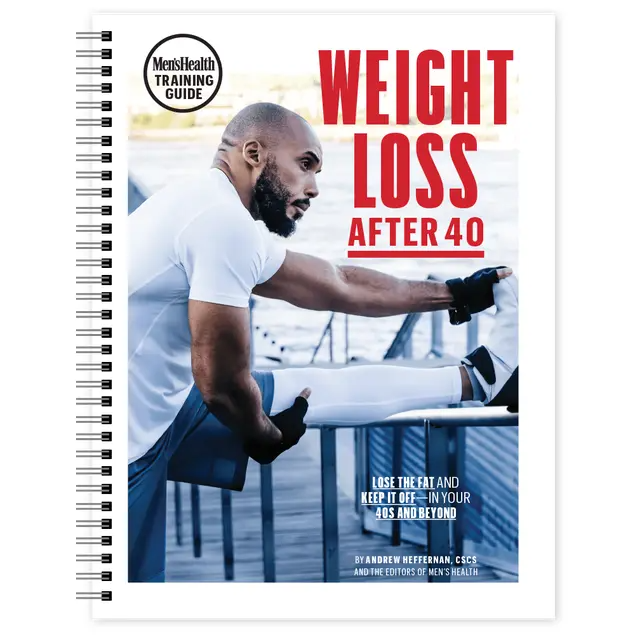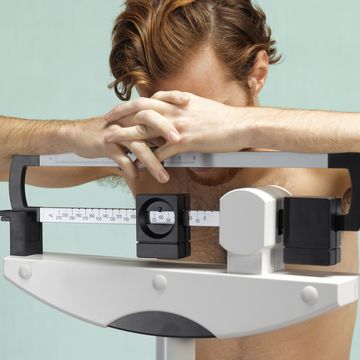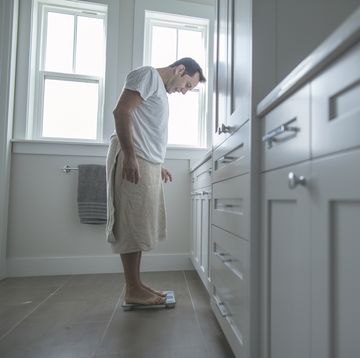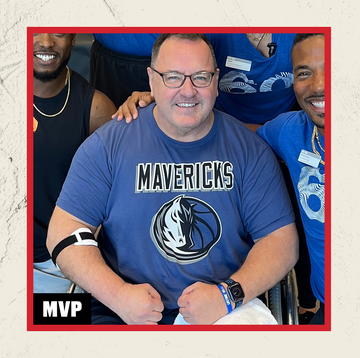THE FEELING IS defeating.
You're well into your weight loss journey and you step on the scale for a week or more and the number is ... the same.
Losing weight involves a fair amount of motivation, at least from the start. You jumpstart yourself into high gear at the start—hitting the gym consistently, and making healthy food choices. If you perfect the balance of calories in and calories out, you'll start to see the pounds shed right off. A small victory dance may follow every time you get off the scale in the morning. These little twinges of success might be enough to motivate you even more than at the beginning.
But, inevitably, that success starts to slow. You're still doing everything right—the gym has become your second home and you've eaten more almonds then you can imagine. But, day after day, weigh in after weigh in, the same number seems to be appearing up on that dumb little screen. You haven't changed anything about your actions—why won't the weight come off anymore? Is the scale broken?
We wish we could say the answer to the mystery lies in that last question. A broken scale would feel like a way less daunting problem. In reality, when this happens, you've likely hit the dreaded weight loss plateau.
The plateau doesn't only take a toll on your weight loss achievements, but it can kill your motivation. Seeing that same number over and over again is enough of a reason to slow your once inspired roll. You may be more willing to skip the gym on days you don't feel like going, or you may feel more inclined to pick up that free cookie at the office birthday party.
While it’s a bummer when your fat loss slows, hitting a weight loss plateau is completely normal and even expected.
“The leaner you get, the harder it gets to lose those last few pounds,” says Tony Gentilcore, C.S.C.S., owner of CORE in Brookline, Massachusetts.
The mechanism is interesting: As you continue losing weight, your metabolism starts to slow down, so you either need to eat fewer calories or burn more calories to see continued weight loss.
In fact, a five to 10 percent decrease in body weight can drop your metabolic rate by about 15 percent, says Holly Lofton, M.D., obesity medicine expert at NYU Langone.
"This is why the last five pounds are so hard," she says.
But “hard” doesn’t automatically mean impossible. There are small changes you can make to how you approach weight loss in order to help you lose the pounds you’re looking for.
Consider the following tips and strategies your new weight loss plateau battle plan.
What Is a Weight Loss Plateau?
A weight loss plateau is a result of the gradual shift in how many calories your body needs when you lose weight. As you get leaner, your body needs few calories to function. If you don't adjust your diet your exercise accordingly, it can result in the dreaded weight loss plateau.
How to Break a Weight Loss Plateau
In order to break a weight loss plateau, you have to either eat less or exercise more. Depending on other factors like your sleep schedule or stress levels, this can be easier said than done.
But it is possible to lose fat after a weight loss plateau. Here, are 12 ways you can get back on track.
Eat Enough Protein
Your metabolism slows when you lose weight because your body doesn't require the same level of energy to maintain your size, according to Roy Gildersleeve, R.D.N., L.D. at The Ohio State University.
Then, you have to account for the loss of muscle mass that naturally occurs when you shed pounds. The more muscle you have, the more calories you burn, so "the goal is to preserve that muscle," says Gildersleeve.
To do this, you'll want to keep protein intake between .8 grams to 1 gram of protein per kilograms of body weight.
If that sounds like a lot of work, consider adding a protein powder supplement into your diet.
Portion Out Your Food
A lot of men devalue the importance of portion sizes, says Gentilcore. You might think eyeballing the amount of food you eat isn’t doing much harm, but it can make a big difference when you’re trying to shed those last few pounds.
Say, if you add just a couple extra tablespoons of peanut butter to your daily smoothie, that’s around 120 extra calories, adding up to 840 extra calories a week.
“As you get a little bit closer to your target weight, you have to be a bit more meticulous,” says Gentilcore.
If you’ve stopped seeing results, you need to pay attention to portion control. First, familiarize yourself with what you should actually be eating. For instance, a serving of beef is 3 ounces (about the size of a deck of cards) and a serving of ice cream is half a cup (about the size of half a tennis ball). Then, measure it out, Gentilcore says. After you get used to what that amount looks like, you can go back to eyeballing your portions.
Watch Post-Workout Overeating
After a hard workout, you've earned the right to eat more, right? And, don't you need to refuel anyway?
Well, that kind of mindset can stunt your weight loss, says John Raglin, Ph.D. an exercise researcher at Indiana University Bloomington’s School of Public Health.
“You could run an extra five miles, but it’s really easy to reward yourself with more than 500 calories,” he says. “The reward usually far exceeds the extra calories you expended.”
These excess calories stack up: If you eat a 500-calorie treat several times a week, that could be an extra day’s worth of calories each week, or more than 6,000 calories per month. And that can make a big difference if you can’t seem to move the scale, says Raglin.
Instead of binging on a sundae because you “earned it,” choose smaller portions of treats you really love, suggests Raglin, like a really decadent piece of dark chocolate or one scoop of your favorite, high-quality vanilla ice cream.
And if you're ever finding that you're exercising to burn off food or to deplete your calories so that you can indulge more later, that's a warning sign that your mental approach to weight loss might not be the healthiest.
Also, that whole "refueling" properly thing? More on that later.
Don't Overestimate Activity Level
When you start working out more, you might experience something called “compensatory inactivity,” says Raglin. That means you might be exercising more, but moving less throughout your day.
Many people fall into this habit of “keeping score.” You bust your butt during your morning sweat session. Then when you get home, you plop down on the couch for the rest of the day to binge watch your favorite Netflix show because you feel like you’ve already done enough for the day.
That’s a mistake: If you’re serious about keeping up with your weight loss, falling into this habit of not moving after exercising can really hold you back, says Raglin.
“Don’t miss out on opportunities to walk or be active or take the stairs,” he says. “It’s a small difference, but you’re keeping your metabolism up.”
What’s more, incorporating more movement throughout your day can keep you motivated, says Raglin. Make an effort to be active whenever you can—take your dog for a walk, kick around a soccer ball with your kids, have an impromptu dance party, or give yourself a daily step count target.
If you can find ways to work in micro-exercises throughout the day, the pounds will keep coming off, Raglin says.
Fuel up the Right Way
Sticking to a high-intensity routine boosts your appetite, says Raglin. You might end up feeling ravenous post-workout, causing you to overeat and gain all of those calories back instantly.
So play the preventive game: If you’re hungry going into your workout, chances are good you’ll be starving afterward. In that case, consider having a pre-workout snack to manage your hunger, says Raglin. You don’t want something too heavy or rich, which can make you feel uncomfortably full. Instead, shoot for an apple, which is full of simple carbs to give you energy, or a handful of almonds, which contain good fats and some protein to hold your hunger over. Or you can try one of these protein bars.
Be Consistent in the Gym
Consistency matters when you’re trying to lose that last bit of weight, says Gentilcore. In fact, skipping just one workout can increase your odds of missing another one by 61 percent, according to British research.
This doesn't have to mean you have to be a workout perfectionist, but it does drive home the fact that hard work, over time, adds up.
And consistency matters in your routine, too. Despite what you may hear, novelty doesn’t necessarily equal progress, says Gentilcore. For a fat loss program to work, you have to stick to a routine long enough so you can really master it.
“The squat, deadlift, and bench press are staples for a reason,” he says. “People don’t give themselves enough time to learn and master these moves.”
The sooner you become proficient at an exercise, the better you get at it. That means you can add more weight to it, helping you gain and retain muscle—which helps you burn more calories throughout the day and fend off fat. But if boring really bothers you, add new stuff to the last 10 minutes of your usual routine as a finisher, suggests Gentilcore.
Then, usually after about 4 to 6 weeks, you can think about switching your exercises up, says Gentilcore. Once you’ve mastered your staples, you can seek out some more challenging variations, like switching up the classic flat bench press with the incline or close-grip bench press.
And if you don't feel yourself growing bored, that's okay too!
Do Recovery the Right Way
Being too sore to work out hurts in more ways than one.
You’re not going to maintain or continue your weight loss if you’re too sore to keep up with your workout plan out for the rest of the week.
Not taking your recovery period seriously can cause you to plateau, says Gentilcore. When you pump iron, you’re literally breaking down your body by causing micro tears in your muscle tissues, so you need give it time to rebuild that muscle before you get back into it.
“People don’t understand that going home and eating well, going to sleep, and drinking enough water is going to allow your body to recover so you can go back to the gym a day later so you can do it again,” he says.
When you’re first starting out, training three days a week seems to be a happy medium for most guys, says Gentilcore. Or you can do full body workouts every other day and allow a day of recovery in between.
But if you really want results, Gentilcore says it doesn’t hurt to get in the gym 6 days a week, just make sure you’re alternating muscle groups, he says. So if Monday is your chest day, work your legs Tuesday to give your upper body time to recover.
And, remember, some soreness is a natural part of exercise recovery. It's when that soreness becomes painful or debilitating that it can pose a risk.
Stress Less and Sleep More
Gildersleeve recommends people analyze more than just their diets when the scale refuses to budge. It might be time to fire up your sleep tracker too.
Worrying more and logging less than six hours of sleep per night can impact your waistline, he says. That's because stress and sleep changes hormone function and increases cortisol levels, which is tied to excess weight and belly fat.
"I can’t stress the importance of REM sleep when it comes to weight loss," says Gildersleeve. In addition, higher cortisol levels stimulate hunger, particularly for junk food, says Gildersleeve.
Track Your Food
There's a reason that people attribute their weight loss success to food journals: it offers a clear idea of what you're really eating. Many times people think they've plateaued while eating the same foods, doing the same exercise, and getting the same amount of sleep. But that generally isn't the case, Gildersleeve says.
"If we’re keeping a healthy [calorie] deficit, eating whole foods, and getting plenty of sleep and water, the likelihood of a plateau is much less," he says.
Although tracking your workouts, calories, and sleep may not be for everyone, it can help dieters ensure they're truly being consistent. However, this habit can be trigger disordered eating habits in some people, so steer clear if you feel like you're beginning to become obsessed with the practice.
Eating Enough Food
Your body adapts to whatever fuel you give it, meaning that you can get used to living on fewer calories over time.
"If on average you’re only taking in 1,200 calories, which is something none of us should be doing on a regular basis, your body is going to learn to function on 1,200 calories," Melanie Boehmer, R.D. at Lenox Hill Hospital.
That's why experts say you should lose weight slowly. Boehmer recommends reducing calorie intake by just enough to lose about a pound per week.
(And juuuust in case you need help calculating how to do that, here's your complete guide.)
"When we talk about losing weight, the goal is always to lose as much weight eating the most that you can so you don’t create that metabolic inhibitor," she says.
Drink Enough Water
It goes without saying—water affects almost everything your body does, including losing weight.
When you're dehydrated, your body may mistake wanting water for wanting food. So, you may be more inclined to reach for a snack rather than your trusty water bottle. Keeping hydrated ensures that you stay fuller, longer. A 2016 study found that those who were adequately hydrated had a lower BMI then those who were not.
Limit Alcohol Intake
Your favorite cocktail may have more calories than you think. For example, a margarita can contain upwards of 300 calories. Aside from its calorie content, alcohol can also lead you to eat more overall.
And watch those craft beers, too, some of which can carry upwards of 300 calories a can.
People who drank an alcohol infusion that equaled roughly two drinks consumed 30 percent more food than those who received a placebo, according to the American Journal of Clinical Nutrition.
If you've stopped losing weight, it may be time to cut back on the number of alcohol drinks you have per week, or switch to something a little more low-calorie.
Know the Difference Between "Healthy" and "Low-Calorie" Foods
It's common for dieters to load up on large quantities of calorie-dense foods that are considered healthy, says Lofton.
"People have handfuls of nuts whenever they’re hungry," she says. If you reach for a serving of nuts several times a day it's easy to eat upwards of 600 extra calories.
She also sees dieters load up a fiber-rich bowl of oatmeal with nuts, dried fruit, coconut, and nut butters—which causes them to exceed their daily calorie needs. Just because a food is considered healthy doesn't mean that it's low in calories. Ultimately, keeping calories low is the key to weight loss. So, if you're trying to lose weight, it's important to be mindful about everything you eat.
Alisa Hrustic is the deputy editor at Prevention, where she leads the brand’s digital editorial strategy. She’s spent the last five years interviewing top medical experts, interpreting peer-reviewed studies, and reporting on health, nutrition, weight loss, and fitness trends for national brands like Women’s Health and Men’s Health. She spends most of her days diving into the latest wellness trends, writing and editing stories about health conditions, testing skincare products, and trying to understand the next greatest internet obsession.


















